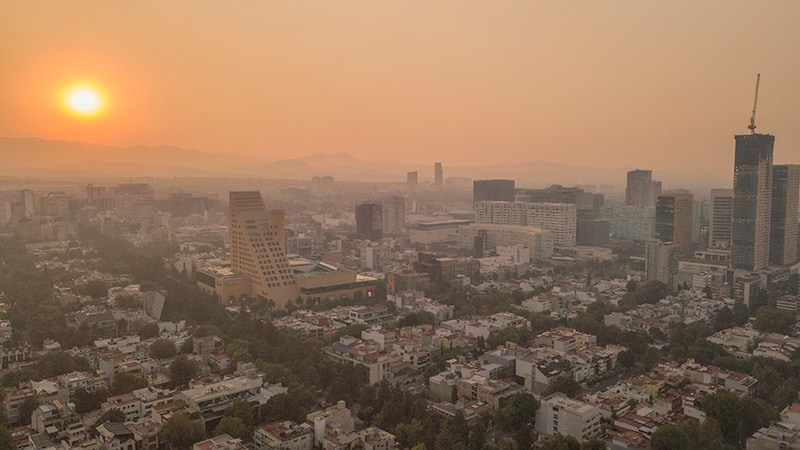Climate Change Worsens Air Pollution–Linked Health Problems


Air Pollution: A Major Environmental Risk to Public Health in the Americas

Air pollution is the main environmental risk to public health in the Americas, where around 380,000 premature deaths were attributed to this cause in 2019, according to the Pan American Health Organization.
Worldwide Exposure to Pollutants
Data from the World Health Organization (WHO) showed that almost all (99%) of the world’s population is exposed to air with pollutant levels that exceed the limits established in its guidelines. Among the most dangerous pollutants for public health, the United Nations agency highlighted suspended particles smaller than 10 and 2.5 µm in diameter (particulate matter-10 [PM10] and PM2.5, respectively), ozone, nitrogen dioxide, sulfur dioxide, and carbon monoxide.
Health Risks Associated with Air Pollution
Exposure to polluted air, especially air polluted with PM10 and PM2.5, is the main risk factor for the development of respiratory and cardiovascular disorders such as ischemia, myocardial infarction, stroke, and chronic obstructive pulmonary disease. Outdoor pollution is responsible for 80% of deaths from heart diseases and strokes, while the remaining 20% correspond to respiratory disorders and cancer.
Sustainable Development Goals (SDGs)
The burden of morbidity and mortality associated with air pollution is classified by the WHO as the second most important risk factor for noncommunicable diseases. It is exacerbated by increasing industrialization and the effects of climate change, making it much more dangerous for exposed populations, especially children and the elderly. Addressing air pollution is crucial to achieving several Sustainable Development Goals (SDGs), including SDG 3: Good Health and Well-being, SDG 11: Sustainable Cities and Communities, and SDG 13: Climate Action.
Air Pollution in Mexican Cities
Horacio Riojas-Rodríguez, PhD, director of environmental health at the Center for Studies in Population Health of the National Institute of Public Health, explained that the riskiest pollutants differ according to region. In cities like Monterrey, Mexicali, and some in the Bajío region, the greatest problems are with high concentrations of PM10 particles. For the Mexico City metropolitan area, the main pollutants are PM2.5 and ozone.
Air Quality Standards in Mexico
Various Mexican institutions, including the National Institute of Public Health, have participated in updating air quality standards since 2014. The maximum permissible levels of pollutants were reduced in the 2019 update, and it was established that particles should be reduced every 2 years to approach WHO criteria. The federal Ministry of Environment extended pollutant measurements to all cities in the country in 2019, obliging local governments to issue recommendations on air quality and associated risks.
Challenges in Achieving Desired Air Quality Levels
The most recent change in air quality regulations was made in 2023 and came into effect this year. However, pollutant concentrations in Mexican cities are still four times higher than the levels established in WHO recommendations. Efforts to reduce PM10 particle levels and ozone concentrations in the Mexico City metropolitan area could prevent thousands of deaths per year, particularly among people aged 65 and older.
Negative Biologic Effects of Air Pollution
Air pollution, especially PM2.5 particles, can cause a range of negative biologic effects. These include respiratory diseases, cardiovascular disorders, cerebral alterations, reproductive issues, endocrine alterations (such as insulin resistance and diabetes), and an increased susceptibility to respiratory infections like SARS-CoV-2, influenza, and tuberculosis.
Effects of Endotoxins in Air Pollution
PM2.5 particles contain a component called endotoxin, which can cause damage beyond the cardiovascular and pulmonary systems, especially affecting kidney function. High concentrations of endotoxin have been associated with poorer kidney function and longer hospital stays in critically ill patients. Animal models have also shown that endotoxin can induce acute and chronic changes in kidney function.
Importance of Monitoring Other Pollutant Components
Monitoring other components of particulate matter, such as endotoxins, could help explain the health phenomena observed in the Mexican population and guide actions to mitigate the emission of these pollutants. Raising awareness among the population and medical personnel about the health problems associated with air pollution is essential.
Riojas-Rodríguez and Aztatzi-Aguilar reported no relevant financial relationships.
This story was translated from the Medscape Spanish edition using several editorial tools, including AI, as part of the process. Human editors reviewed this content before publication.
Source: medscape.com








